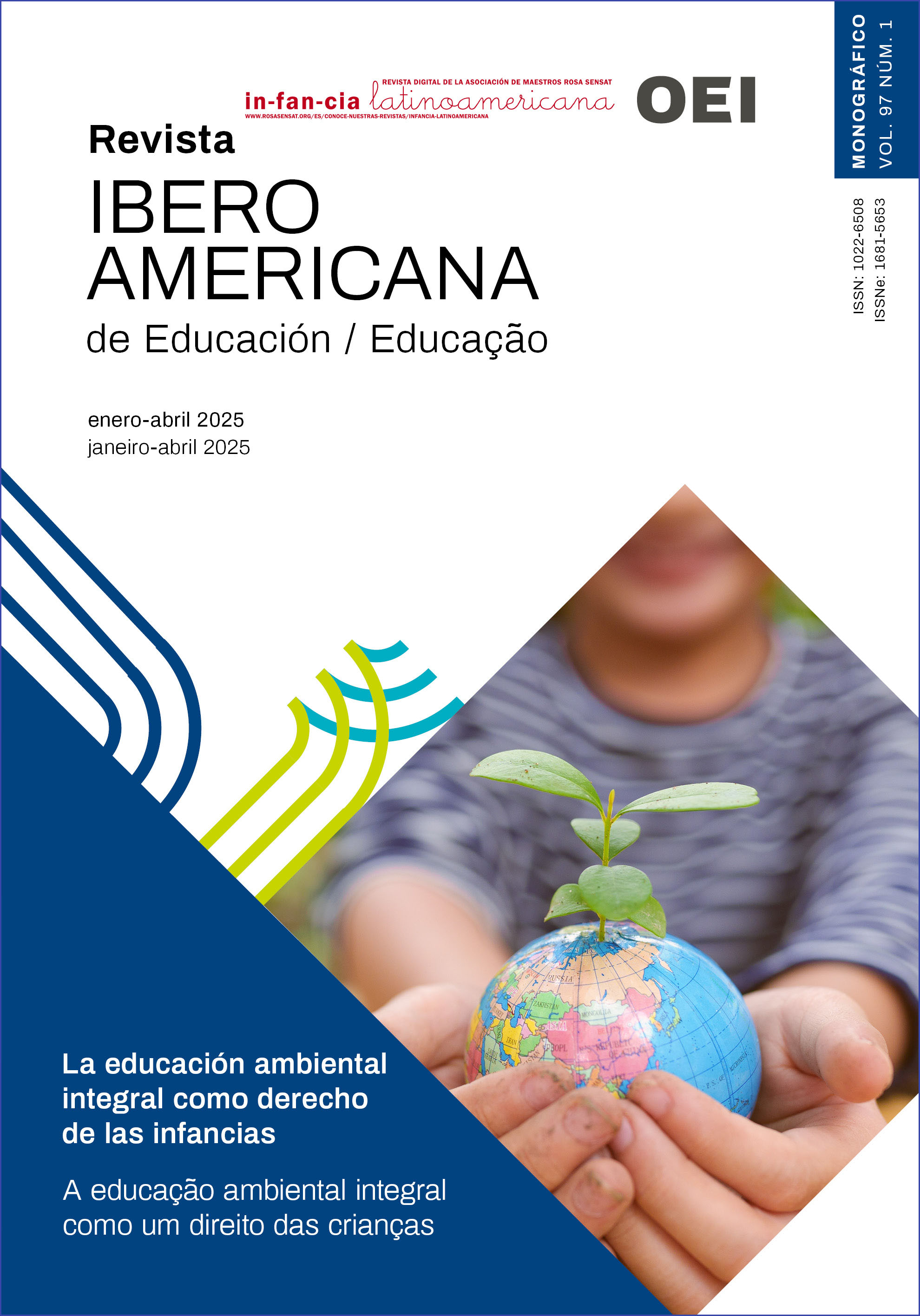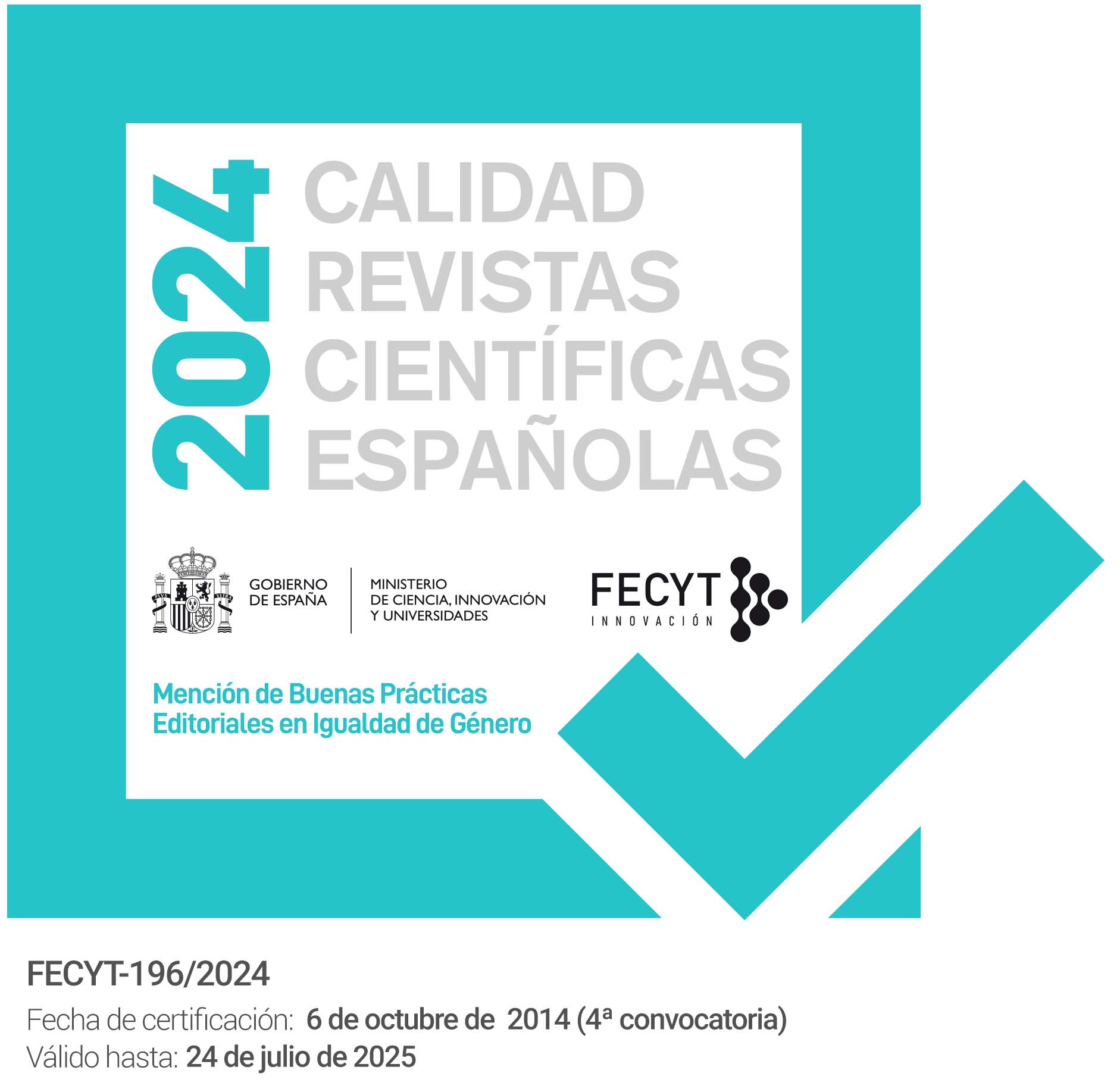Interculturality beyond borders: hermeneutics of the concept in learning projects developed on the Portuguese-Spanish border
DOI:
https://doi.org/10.35362/rie9716644Keywords:
Interculturality, Border, Learning Projects, EducationAbstract
The concept of interculturality undertakes a variable understanding depending on the theoretical frameworks mobilized and the social and geopolitical contexts in which it is applied. This study aims to understand its hermeneutics in the learning projects developed in the 2021/2022 course of the “Proyecto Escuelas Bilingües e Interculturales de Frontera”. Implemented in 1st to 6th grade classes in schools in the Luso-Spanish border, the projects were analyzed considering the categories: (1) knowledges about cultural elements beyond borders and (2) intercultural educational dynamics. The results show that most of the projects prioritize knowledges about objective regional and national culture, apart from one, which adopts a global citizenship perspective. These knowledges assumed a practical strand in performative intercultural dynamics, using multiliteracies; and relational, visible above all in cross-border meetings and in the involvement of various stakeholders in a paradigm of school as an ecosystem.
Downloads
References
Anderson, J., & Macleroy, V. (2017). Connecting worlds: interculturality, identity and multilingual digital stories in the making. Language and Intercultural Communication, 17(4), 494-517. https://doi.org/10.1080/14708477.2017.1375592 DOI: https://doi.org/10.1080/14708477.2017.1375592
Araújo e Sá, M. H., Matesanz, M., & Martins, V. (2022) Guião para a construção do projeto de aprendizagem numa perspetiva de investigação-ação e em rede. Universidade de Aveiro e Universidad Complutense de Madrid.
Bakhtin, M. (1981). The dialogic imagination: Four essays. (C. Emerson & M. Holquist, trad.). University of Texas Press.
Bardin, L. (2009). Análise de conteúdo. (L. Reto & A. Pinheiro, trad.). Edições 70.
Beacco, J. C., Byram, M., Cavalli, M., Coste, D., Cuenat, M. E., Goullier, F., & Panthier, J. (2016). Guide for the development and implementation of curricula for plurilingual and intercultural education. Council of Europe. https://doi.org/10.3917/europ.beac.2016.02 DOI: https://doi.org/10.3917/europ.beac.2016.02
Bennett, M. (2013). Basic concepts of intercultural communication: Paradigms, principles & practices (2.ª ed.). Intercultural Press. (Original publicado em 1998).
Benson, P. (2021). Language Learning Environments: Spatial Perspectives on SLA. Multilingual Matters. DOI: https://doi.org/10.21832/9781788924917
Bhabha, H. (1994). The Location of Culture. Routledge.
Bosio, E. & Torres, C. A. (2019). Global citizenship education: An educational theory of the common good? A conversation with Carlos Alberto Torres. Policy Futures in Education, 17(6), 745–760. https://doi.org/10.1177/1478210319825517 DOI: https://doi.org/10.1177/1478210319825517
Brito de Arruda, G., & Pereira Tamwing, M. (2023). O caso do portunhol: uma língua de fronteira(s). Revista Geadel, 4(1), 145–157. https://doi.org/10.29327/269116.4.1-11 DOI: https://doi.org/10.29327/269116.4.1-11
Bruner, J. S. (1990). Acts of meaning. Harvard University Press.
Byram, M. (1997). Teaching and Assessing Intercultural Communicative Competence. Multilingual Matters.
Candelier, M., Camilleri-Grima, A., Castellotti, V., Pietro, J., Lörinez, I., Meissner, F., Schröeder-Sura, A., Noguerol, A., & Molinié, M. (2010). Framework of reference for pluralistic approaches to languages and cultures. Council of Europe. https://lc.cx/1Ev8Hz
Carinhas, R., Araújo e Sá, M. H., & Moore, D. (2020). Mi calle favorita: a reconstrução multimodal da paisagem da Ciudad Vieja de Montevideu num projeto plurilíngue entre a escola, os museus e as famílias. Domínios de Lingu@gem, 14(4), 1059–1086. https://doi.org/10.14393/DL44-v14n4a2020-2 DOI: https://doi.org/10.14393/DL44-v14n4a2020-2
Cope, B., & Kalantzis, M. (2020). Adding Sense: Context and Interest in a Grammar of Multimodal Meaning. Cambridge University Press. DOI: https://doi.org/10.1017/9781108862059
Council of Europe (2020). Common European Framework of Reference for languages: learning, teaching, assessment (Companion Volume). https://lc.cx/c6LR1h
Cummins, J., & Early, M. (Ed.). (2011). Identity texts: the collaborative creation of power in multilingual schools. Trentham Books.
Dervin, F. (2021). Characterizing interculturality. In F. Dervin & A. Simpson (Eds.), Interculturality and the Political within Education (1.ª ed., pp. 6-22). Routledge focus. DOI: https://doi.org/10.4324/9780429471155-2
Fantini, A. (2009). Assessing intercultural competence: Issues and tools. In D. K. Deardorff (Ed.), The SAGE handbook of intercultural competence, pp. 456–476. Sage. DOI: https://doi.org/10.4135/9781071872987.n27
Ferri, G. (2018). Intercultural Communication: Critical Approaches and Future Challenges. Palgrave Macmillan. DOI: https://doi.org/10.1007/978-3-319-73918-2_1
Foucault, M. (1979). Microfísica do poder. Graal.
Freire, P. (1970). Pedagogia do oprimido. Paz e Terra. https://lc.cx/oaH7_4
Garbarino, S., & Leone, P. (2020). Innovation dans un projet de télécollaboration orale em intercompréhension: bilan et perspectives du projet IOTT. Open Edition Journals: Alsic, 23(2), 1-20. https://doi.org/10.4000/alsic.4790 DOI: https://doi.org/10.4000/alsic.4790
Gobierno de Portugal & Gobierno de España (2020, septiembre). Estrategia Común de Desarrollo Transfronterizo. https://lc.cx/v_C5u0
Gumperz, J. & Hymes, D. (1972). Directions in sociolinguistics: the ethnography of communication. Holt, Rinehart and Winston.
Hall, E. (1975). The silent language. Doubleday & Company. https://lc.cx/3GqS5Z
Hamman, P. (2019). Frontières fluviales ou espaces-frontières? Regards sociologiques, Cahiers du plurilinguisme européen, 11. https://www.ouvroir.fr/cpe/index.php?id=1124 DOI: https://doi.org/10.57086/cpe.1124
Hann, C. (2016). A concept of Eurasia. Current Anthropology, 57(1), 1–27. https://doi.org/10.1086/684625 DOI: https://doi.org/10.1086/684625
Hanzi, Z. (2019). Avaliação de Competência Intercultural: Estudantes Universitários Chineses de PLE. [Tese de doutoramento, Faculdade de Letras da Universidade de Lisboa]. https://lc.cx/kBz5ED
Hegel, F. (1992). Fenomenologia do espírito (2.ª ed.). (P. Meneses, trad.). Petrópolis. (Original publicado em 1807).
Hoff, H. (2020). The Evolution of Intercultural Communicative Competence: Conceptualizations, Critiques and Consequences for 21st Century Classroom Practice. Intercultural Communication Education 3(2), 55-74. 10.29140/ice.v3n2.264 DOI: https://doi.org/10.29140/ice.v3n2.264
Hofstede, G. (1980). Culture and Organizations. International Studies of Management & Organization, 10(4), 15-41. https://www.jstor.org/stable/40396875 DOI: https://doi.org/10.1080/00208825.1980.11656300
Holliday, A. (2011). Intercultural communication and ideology. Sage. DOI: https://doi.org/10.4135/9781446269107
Jacobucci, D. (2008). Contribuições dos Espaços Não-formais de Educação para a Formação da Cultura Científica. Uberlândia, 7(1), 55-66. https://doi.org/10.14393/REE-v7n12008-20390 DOI: https://doi.org/10.14393/REE-v7n12008-20390
Kalaja, P. & Melo-Pfeifer, S. (2019). Visualising Multilingual lives. More than words. Multilingual matters. DOI: https://doi.org/10.21832/9781788922616
Kastoryano, R. (2018). Multiculturalism and Interculturalism: Redefining Nationhood and Solidarity. Comparative Migration Studies, 6(1), 1-11. https://doi.org/10.1186/s40878-018-0082-6. DOI: https://doi.org/10.1186/s40878-018-0082-6
Kim, T. (2023). Korean Ethnic Nationalism and Modern Education: Christianity and Political Ideologies in Shaping one Nation and Two States. In D. Tröhler (Ed.), Education, Curriculum and Nation- Building: Contributions of Comparative Education to the Understanding of Nations and Nationalism (pp. 124–148). Routledge. DOI: https://doi.org/10.4324/9781003315988-7
Kolosov, V. (2020). Phantom borders: the role in territorial identity and impact on society. Belgeo, 2, 1-20. https://doi.org/10.4000/belgeo.38812 DOI: https://doi.org/10.4000/belgeo.38812
Kramsch, C. (2009). The multilingual subject. What language learners say about their experience and why it matters. Oxford University Press.
Kress, G. (2010). Multimodality, a social semiotic approach to contemporary communication. Routledge.
Lourenço-Simões, C., Araújo e Sá, M. H., & Matesanz del Barrio, M. (2024). Enfocando la interculturalidad: revisión de literatura sobre proyectos y estudios de educación en lenguas realizados en contextos de frontera. Revista de Investigación Educativa, 42(2). https://doi.org/10.6018/rie.565531 DOI: https://doi.org/10.6018/rie.565531
Matesanz del Barrio, M., Martins, V., & Araújo e Sá, M. H. (2023). Projeto Escolas bilingues e interculturais de fronteira (PEBIF): um projeto transfronteiriço e integrador na Península Ibérica. Revista Iberoamericana de Educación, 93(1), 45-65. https://doi.org/10.35362/rie9315998 DOI: https://doi.org/10.35362/rie9315998
Matesanz del Barrio, M. (2019). Conciencia lingüística en la construcción de discursos multilingües: la intercomprensión espontánea en portuñol. Revista Iberoamericana de Educación, 81(1), 75-96. https://doi.org/10.35362/rie8113557 DOI: https://doi.org/10.35362/rie8113557
Matsuo, C. (2016). A dialogic critique of Michael Byram’s intercultural communication competence model: Proposal for a dialogic pedagogy. In N. Tomimori (Ed.), Comprehensive study on language education methods and cross–linguistic proficiency evaluation methods for Asian languages: Final report (2014) (pp. 3–22). Tokyo University of Foreign Studies.
Melo-Pfeifer, S., & Araújo e Sá, M. H. (2018). Multilingual interaction in chat rooms: translanguaging to learn and learning to translanguage. International Journal of Bilingual Education and Bilingualism, 21(7), 867-880. https://doi.org/10.1080/13670050.2018.1452895 DOI: https://doi.org/10.1080/13670050.2018.1452895
Mondada, L. (2016). Challenges of multimodality: Language and the body in social interaction. Journal of Sociolinguistics, 20(3), 336–366. https://doi.org/10.1111/josl.1_12177 DOI: https://doi.org/10.1111/josl.1_12177
New London Group (1996). A pedagogy of multiliteracies: designing social futures. Harvard Educational Review, 66(1), 60-92. https://doi.org/10.17763/haer.66.1.17370n67v22j160u DOI: https://doi.org/10.17763/haer.66.1.17370n67v22j160u
Orsini-Jones, M., & Lee, F. (2018). Intercultural communicative competence (ICC) revisited. In M. Orsini-Jones & F. Lee (Ed.), Communicative competence for global citizenship (pp. 7–23). Palgrave Macmillan. DOI: https://doi.org/10.1057/978-1-137-58103-7_2
Paasi, A. (2022). Bounded spaces in question: x-raying the persistence of regions, territories, and borders. Geografiska Annaler: Series B, Human Geography, 104(1), 1-8, https://doi.org/10.1080/04353684.2022.2032791 DOI: https://doi.org/10.1080/04353684.2022.2032791
Pérez-Peitx, M., Civera, I. L., & Palou, J. S. (2019). Awareness of Plurilingual Competence in Teacher Education. In P. Kalaja & S. Melo-Pfeifer (Eds.), Visualising Multilingual lives. More than words, (1.ª ed., pp. 232-254). Multilingual matters. DOI: https://doi.org/10.2307/jj.22730729.19
Piccardo, E., Germain-Rutherford, A., y Lawrence, G. (2022). An Introduction to Plurilingualism and This Handbook. In E. Piccardo, A. Germain-Rutherford & G. Lawrence (Eds.), The Routledge Handbook of Plurilingual Language Education (pp. 1-15). Routledge. DOI: https://doi.org/10.54103/2037-3597/20456
Prasad, G. (2021). Re-framing expertise: learning with and from children as co-investigators of their plurilingual practices and experiences. In A. Pinter & K. Kuchah (Eds.), Ethical and methodological issues in researching young language learners in school contexts (pp. 106–125). Multilingual Matters. DOI: https://doi.org/10.2307/jj.22730595.9
Pratt, M. L. (1999). Arts of the contact zone. In Bartholomae, D. & Petroksky, A. (Ed.), Ways of reading, (5.ª ed., pp. 1-7). Bedford. https://lc.cx/wlB6X1
Putsche, J. (2022). L’interculturel contextualisé: franco-allemand, frontalier, transculturel – Une approche sociodidactique. [Dossier apresentado tendo em vista habilitação para direção de investigadores, Université de Lorraine]. https://hal.science/tel-03882905/document
Quivy, R., & Campenhoudt, L. V. (1995). Manual de Investigação em Ciências Sociais, Trajetos. (J. Marques, M. Mendes & M. Carvalho, trad.). Gradiva.
Radhakrishnan, R. (2013). Why Compare? In R. Felski & S. Friedman, Comparison: Theories, Approaches, Uses (pp. 15–33). The Johns Hopkins University Press.
Raja, R. & Nagasubramani, P. C. (2018). Impact of modern technology in education, Journal of applied and advanced research, v. 3. https://doi.org/10.21839/jaar.2018.v3iS1.165 DOI: https://doi.org/10.21839/jaar.2018.v3iS1.165
Risager, K. (2018). Representations of the world in language textbooks. Channel View Publications DOI: https://doi.org/10.21832/RISAGE9559
Shadiev, R., Wang, X. & Huang, Y. M. (2020). Promoting Intercultural Competence in a Learning Activity Supported by Virtual Reality Technology. International Review of Research in Open and Distributed Learning, 21(3). https://doi.org/10.19173/irrodl.v21i3.4752 DOI: https://doi.org/10.19173/irrodl.v21i3.4752
Simpson, A., & Dasli, M. (2023) Concluding remarks on intercultural communication pedagogy and the question of the other. Pedagogy, Culture & Society, 31(2), 325-337. https://doi.org/10.1080/14681366.2022.2164337 DOI: https://doi.org/10.1080/14681366.2022.2164337
Simpson, A., & Dervin, F. (2019). The Council of Europe Reference Framework of competences for democratic culture: Ideological refractions, othering and obedient politics. Intercultural Communication Education, 2(3), 102–119. https://doi.org/10.29140/ice.v2n3.168 DOI: https://doi.org/10.29140/ice.v2n3.168
Simpson, A., & Dervin, F. (2020). Forms of Dialogism in the Council of Europe Reference Framework on Competences for Democratic Culture. Journal of Multilingual and Multicultural Development, 41(4), 305–319. https://doi.org/10.1080/01434632.2019.1618317 DOI: https://doi.org/10.1080/01434632.2019.1618317
Walsh, C. (2012). Interculturalidad y (de)colonialidad: Perspectivas críticas y políticas. Visão global, 15(1-2), 61-74. https://lc.cx/smIzXA
Yang, R. (2018). The use of questions in a synchronous intercultural online exchange project. ReCALL, 30(1), 112-130. https://doi.org/10.1017/S0958344017000210 DOI: https://doi.org/10.1017/S0958344017000210
How to Cite
Published
Issue
Section
License
Copyright (c) 2025 Iberoamerican Journal of Education

This work is licensed under a Creative Commons Attribution 4.0 International License.
Any authors who publish with this journal accept the following terms:















